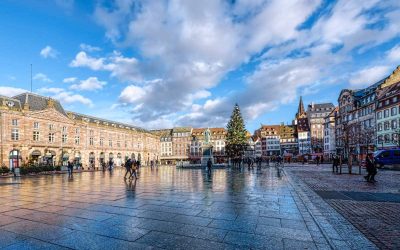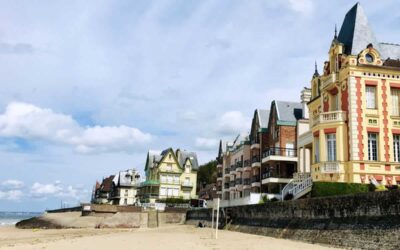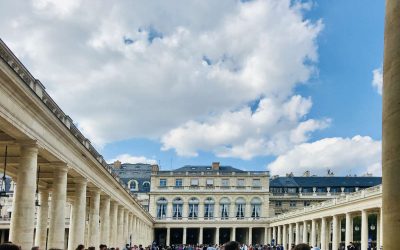France is a country with so much rich history, it can seems like the entire country should be on a protected list. From soaring medieval cathedrals to imposing castles all over the country, it can be difficult to know where to begin.
The World Heritage List is created by UNESCO to protect sites of “outstanding universal value” to humanity. With different categories for culture and nature, there are so many beautiful UNESCO world heritage sites in France it is hard to choose which ones to visit.
Having traveled to many of these sites, I can say however there are ones that clearly stand out for their history as much as their beauty. So let’s have a look at the most beautiful UNESCO World heritage sites in France, shall we? Allons-y!
- 1. Palais de Versailles
- 2. Pont du Gard
- 3. Carcassone
- 4. Canal du Midi
- 5. Roman amphitheatre in Arles
- 6. Reims Cathedral
- 7. Grotte Chauvet
- 8. Mont-Saint-Michel
- 9. Château de Fontainebleau
- 10. Loire Valley Châteaux
- 11. Provins
- 12. Strasbourg Grand Ile
- 13. Route of Santiago de Compostela
- 14. Episcopal City of Albi
- 15. Notre-Dame Cathedral of Chartres
- 16. Champagne hillsides, houses and cellars
- 17. Paris, banks of the Seine
- 18. Historical center of Avignon
- 19. Fortifications of Vauban
- 20. Nice, winter resort town
- 21. Spa towns of France
- 22. Place Stanislas, Place de la Carrière and Place d'Alliance in Nancy
- 23. Historic center of Lyon
- 24. Le Havre, the city rebuilt
- 25. Amiens Cathedral
- 26. Saint-Emilion (Bordeaux)
- 27. Rocamadour
1. Palais de Versailles
It was built by the famous Sun King Louis XIV of France, but we think more today of the tragic destiny of Marie-Antoinette and the French Revolution. The Château de Versailles is a palace that is officially recognized as a UNESCO World heritage site.
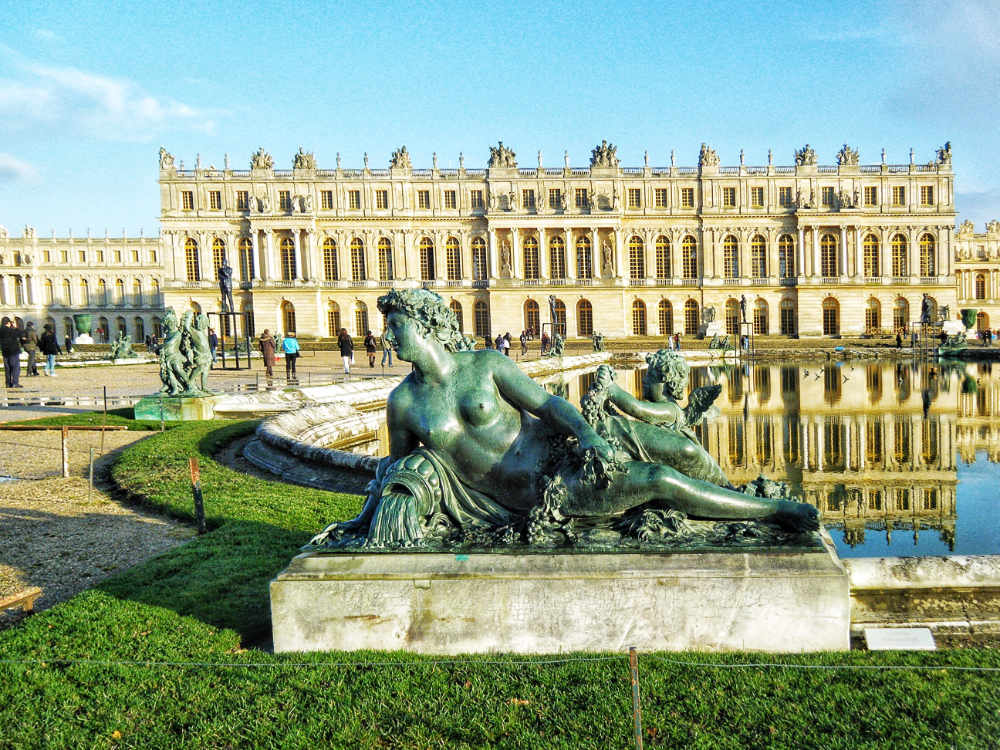
☞ READ MORE: French travel phrases you need for a trip to France
Many other key moments in history took place here as well, such as the Treaty of Versailles (WW1), subsequent German retaliation (WW2), amongst many others, so wander around and breathe in the history of France.
You can read more about visiting the Château de Versailles here. It does get quite crowded, especially in the summer so I highly advise booking tickets in advance.
2. Pont du Gard
About 72 miles (117 km) away from Aix-en-Provence in the region of Provence, is an ancient Roman aqueduct known as Pont du Gard.
Built over a period of 5 years in the 1st century, the aqueduct was built to carry water to over 50 km (31 miles) to what was then the Roman colony of Nimes.
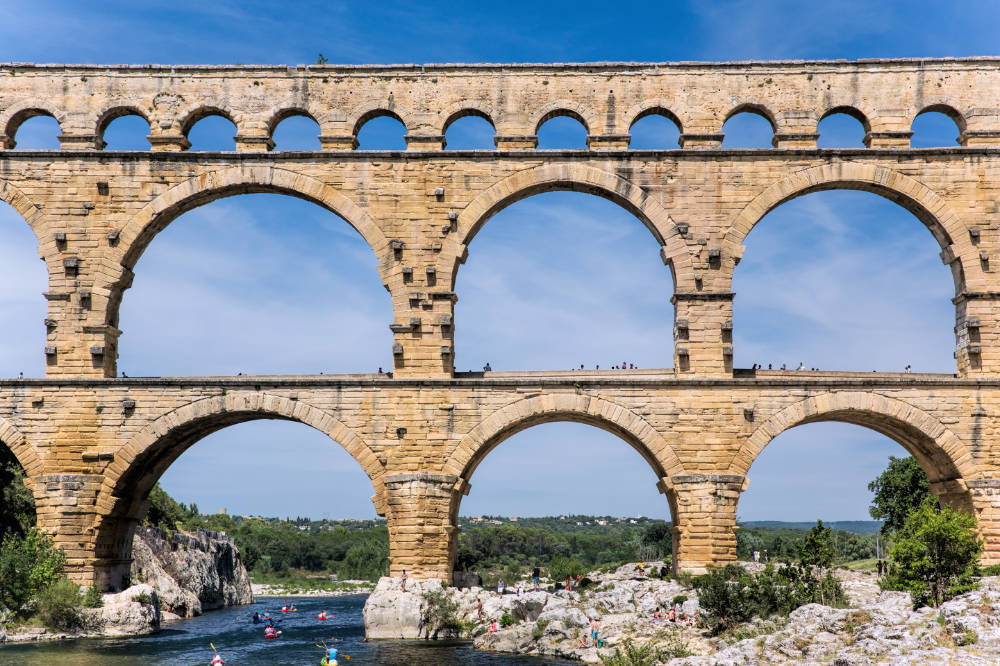
With 3 tiers of arches, it crosses the river Gardon and is the highest of all Roman aqueduct bridges, as well as being one of the best-preserved.
After the Roman empire collapsed, the Pont du Gard remained in use as it also served as a toll bridge for people looking to cross the river. The bridge remained mostly intact, with the Ducs of nearby Uzès being responsible for maintaining the bridge.
Rather than delivering water, the bridge instead became a tourist attraction, with everyone from French Kings to apprentice masons making their way to the bridge to admire its architecture.
In the early 2000s, traffic around the area was rerouted to preserve this UNESCO world heritage site and from pollution and maintain the tranquil nature of the area. Today, it is one of the most popular destinations in France after the Palace of Versailles and Mont Saint Michel.
You will need a rental car to visit, or alternatively you can book a tour from Aix-en-Provence. You can read more about Pont du Gard here.
3. Carcassone
Located in the south of France in Occitanie, one of the most popular tourist attractions in France has to be the in town of Carcassonne.
La Cité de Carcassonne and its Château Comtal, with its enormous walls, look and feel like they belong in another time. And indeed they do, dating back to the Middle ages, when wars were waged on horseback and moats were enough to keep invaders out.
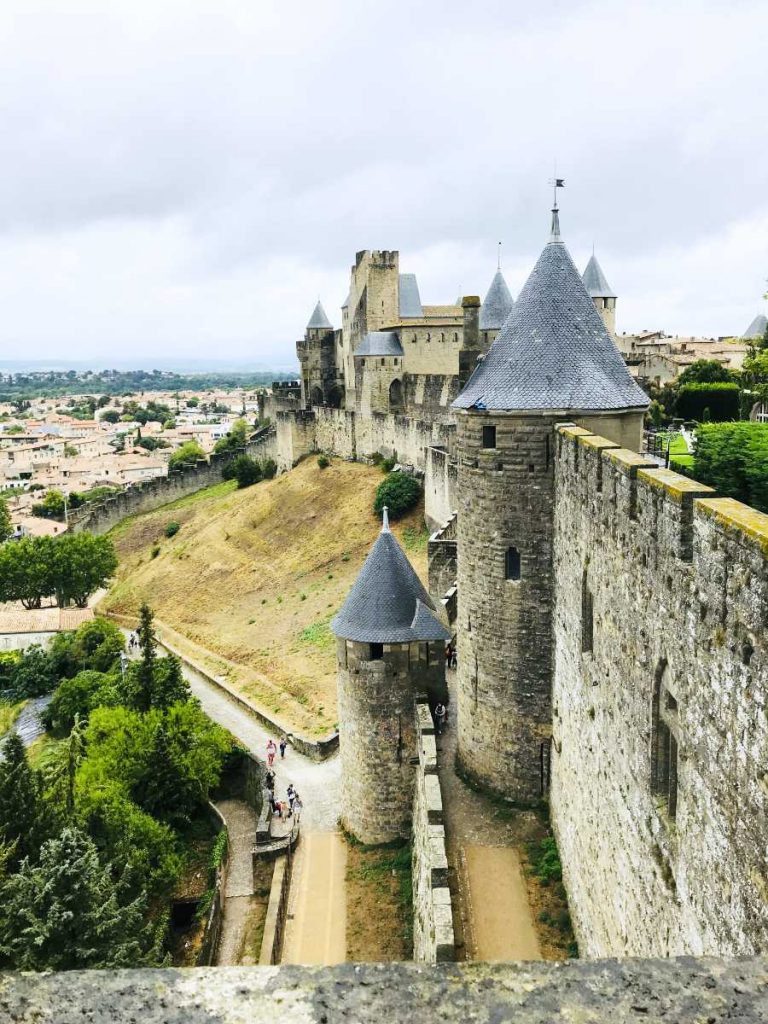
A UNESCO world-heritage site, the Cité de Carcassone is one of the largest of its kind with two outer walls and 53 towers.
The impressive citadel towers on a hilltop, surrounded by wide, stone ramparts that you can walk along and explore. There is quite a lot of see, so to make the most of your day, I suggest taking a guided tour when you arrive at Carcassonne. You can read more about visiting Carcassonne here.
4. Canal du Midi
The Canal du Midi is a man-made river constructed in 1681, located in the Languedoc-Roussillon region in France. Today it is officially recognized as a UNESCO world heritage site.
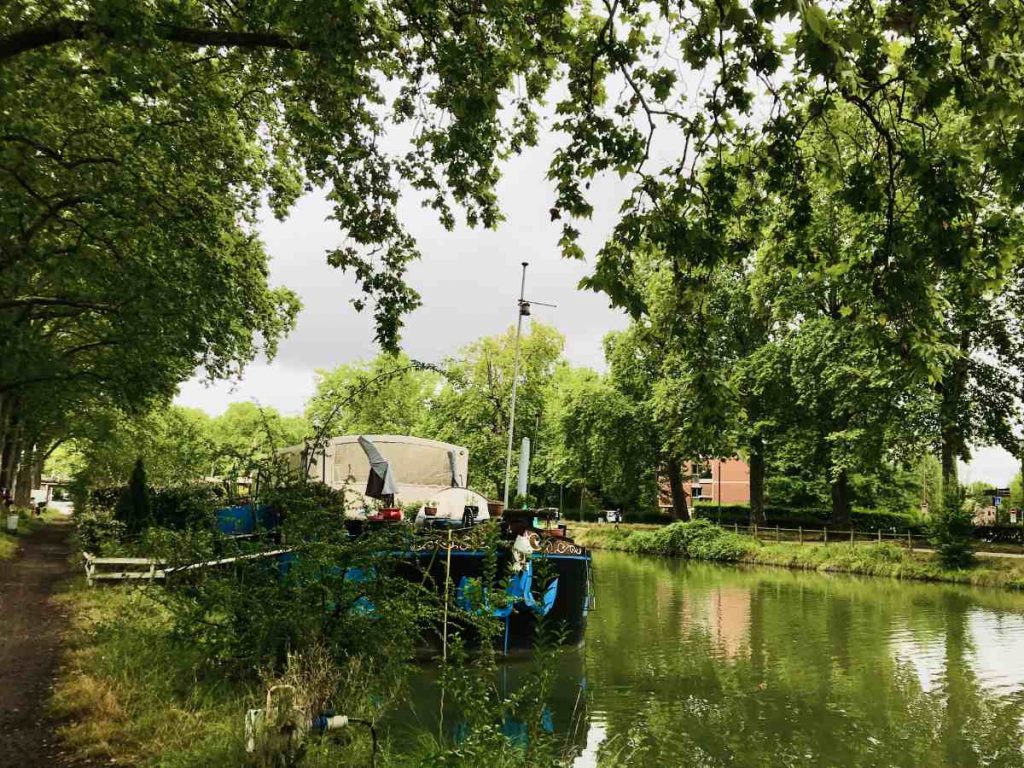
This canal crosses the region between Toulouse and the Mediterranean Sea and ranks as one of the greatest feats of engineering of all time. At over 120 miles (193 km) long, this waterway links the Mediterranean and the Atlantic ocean, making it a crucially important crossroad within France rather than having to go around Spain and the Iberian coastline.
It was constructed by Sun King Louis XIV of France in 1666 (who also built the Palace of Versailles), who let his engineer Pierre-Paul Riquet take the lead on the project. Riquet would spend much of his own fortune to ensure that the Canal was completed in 1681.
It is also exceptionally beautiful, with houseboats along its tree-lined quais and working locks that still adjust water levels. Go for a stroll, a bike ride with a tour guide, or take a boat ride onto its waters. You can read more about the Canal du Midi here.
5. Roman amphitheatre in Arles
Known as Arelate, the city of Arles was once an important Roman settlement on the crossroads of the Rhône river and the Mediterranean sea, as Caesar and his Empire expanded into Gaul and headed west.
The city in southern France has a long history, having considerable importance in the Roman province of Gallia Narbonensis. Today Arles and its Roman ruins are recognized as a UNESCO world heritage site.
With a magnificent amphitheatre, forum, and other Roman buildings, Arles was city that had prospered from trade and commerce. It also has managed to preserve many of its artefacts and ruins, making it one of the best places in France to see the remaining vestiges of the Roman empire.
A clear sign of the city’s importance is the Arles Amphitheatre, that served as a stadium for entertainment and sporting events in the old empire.
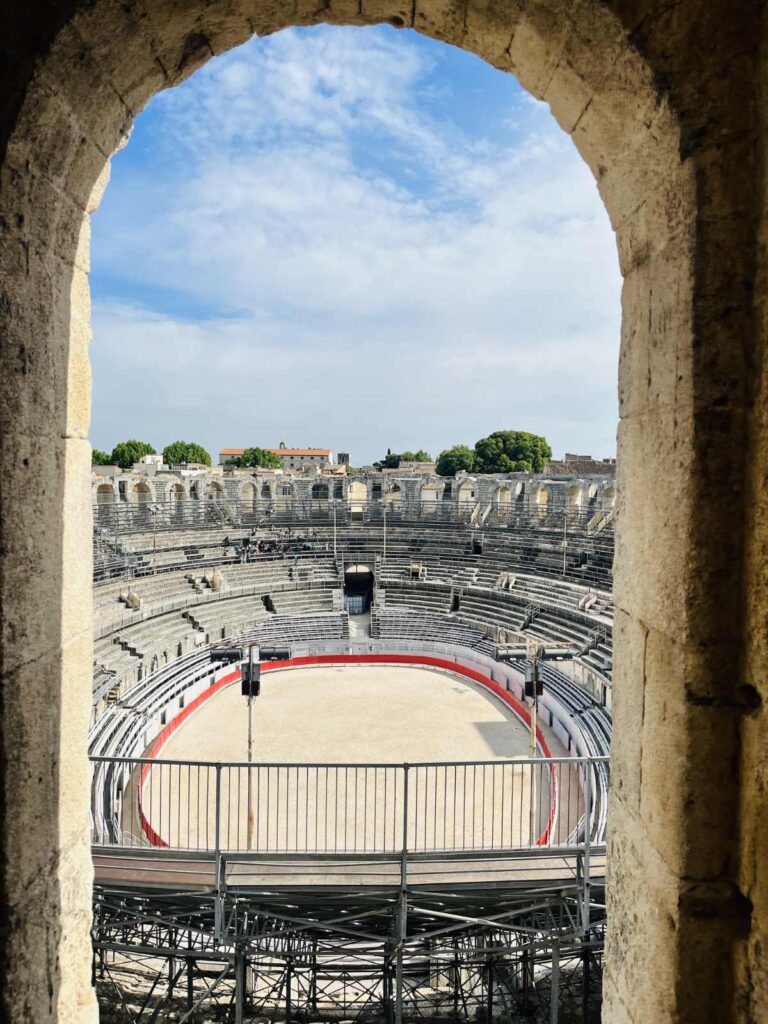
It was built in 90AD, 10 years after the Colosseum was completed in Rome. While the one in Rome is larger holding 65,000 people, the Arles amphitheatre can hold around 20,000. Quite impressive for a town that still only has a population of around 50,000.
Within a few 100 yards of the Arles amphitheatre is the Roman theatre. While gladiators provided the entertainment in the amphitheatre, this Roman theatre was for plays and musical acts.
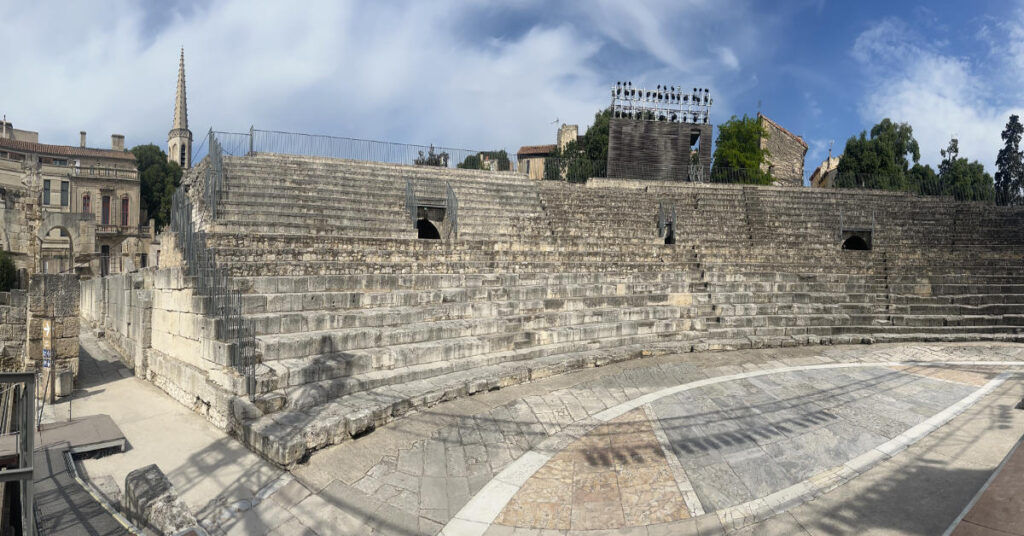
The Roman theatre is actually older than the amphitheatre, having been completed nearly 100 years earlier in 12 BC. It was built to seat around 10,000 people.
At the time, it was highly decorated with statues and sculptures. The famous Venus of Arles, which is now in the Louvre museum, was discovered here during excavations of the ancient theatre.
Along with gladiator sports and the theatre, the Romans were also very fond of the baths. Built in the 4th century, the Thermes de Constantin baths were believed to have been constructed when Emperor Constantine I resided in Arelate as the city was known.
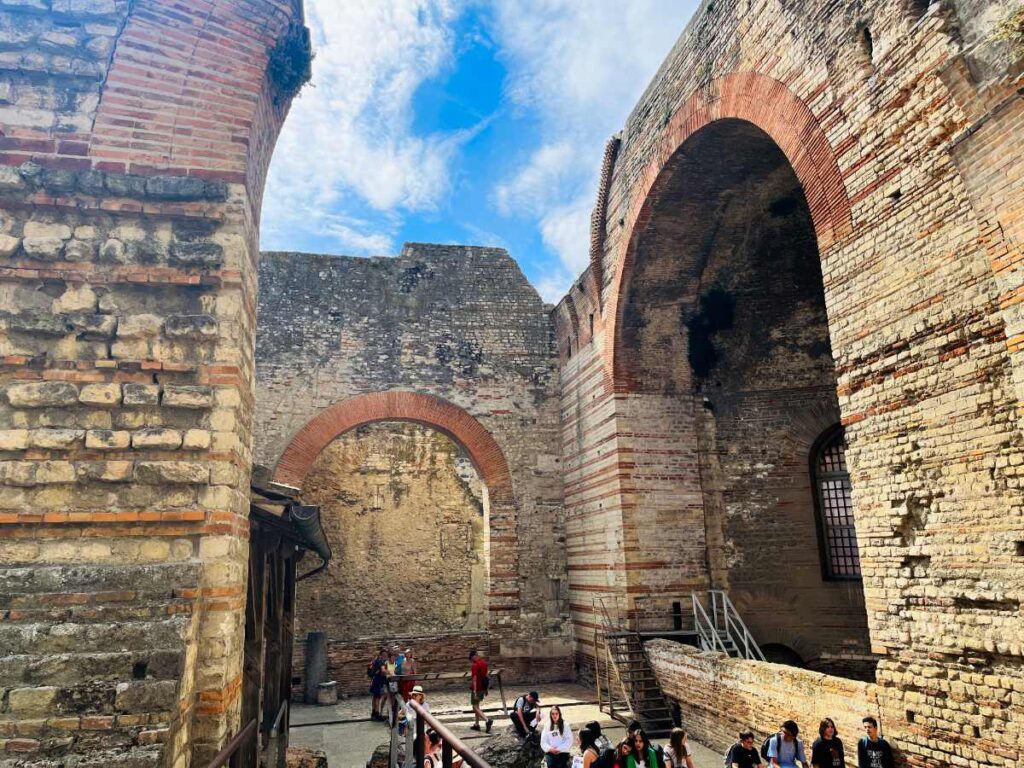
Nearly 3900sqm with grand arches and multiple levels, the bather was required to travel a circuit of hot and cold springs in an effort to restore good health.
The Thermes de Constantin are among the best preserved in France, along with the Thermes de Chassenon in Charente and the Thermes de Cluny in Paris.
6. Reims Cathedral
The Reims Cathedral stands on the spot of an older church that is thought to have been founded by the bishop Nicasius in the early 5th century. It is officially recognized as a UNESCO world heritage site.
It is here in 496AD that St. Rémi is believed to have baptized Clovis I, the 1st King of the Franks into Christianity and the start of the Frankish Empire. (The city of Reims is named after the saint.)

Construction of the current building of Reims Cathedral began in the 13th century. After Clovis, most of the French Monarchs through the centuries were crowned here.
Only a handful were not, including Napoleon Bonaparte who decided to be crowned at Notre Dame de Paris. His successor Louis XVIII also tried to dispense with the tradition, after the guillotine of his uncle King Louis XVI and Marie Antoinette.
The last coronation here was 1825 of Charles X, who was quite unpopular and shortly overthrown after. The Reims Cathedral was one of the buildings substantially destroyed during World War I, which had to be almost entirely rebuilt. A large donation from John D. Rockefeller was able to restore the Cathedral to what we see today.

When you walk through the cathedral, you can’t help but remark upon the extraordinary history of this tourist attraction. All around the exterior and interior facades, there are giant size statues of French Kings and saints.
The building today is an inspiration for the reconstruction of Notre Dame de Paris which was also significantly damaged after a large fire in 2019.
Other famous historic cathedrals in France that are recognized as UNESCO world heritage sites include the Amiens Cathedral (which is the largest in France), Chartres Cathedral, and Bourges Cathedral.
7. Grotte Chauvet
One of the greatest cultural treasures in the world is located in the heart of department of Ardèche, about 124 miles (200 km) away from Lyon.
Known as Grotte Chauvet (Cave Chauvet), it is a cave network which has some of the earliest known Paleolithic human cave paintings. Dating back about 28,000 – 32,000 years old these are among the oldest in the world.

There are several panels with some of the earliest known figurative drawings, making it one of the most important prehistoric art sites in the world. These spectacular images were created by prehistoric humans, or Homo sapiens, as they roamed the European continent.
The actual cave is too fragile to allow visitors, and so an exact replica was built called Grotte Chauvet 2. Built to educate visitors about the Paleolithic era, there is an entire complex of exhibitions to visit about the lives of these prehistoric humans.
Other prehistoric cave complexes called Lascaux and Grotte Cosquer are also on the UNESCO world heritage list, but similarly it is the replicas that are open to visitors. You can read more about visiting Grotte Chauvet 2 here.
8. Mont-Saint-Michel
One of the most beautiful and unique sights in the world, Mont Saint Michel is a sight to behold. Legend has it that the archangel Michael appeared to St. Aubert of Avranches in 708 and instructed him to build a church on a large rock.
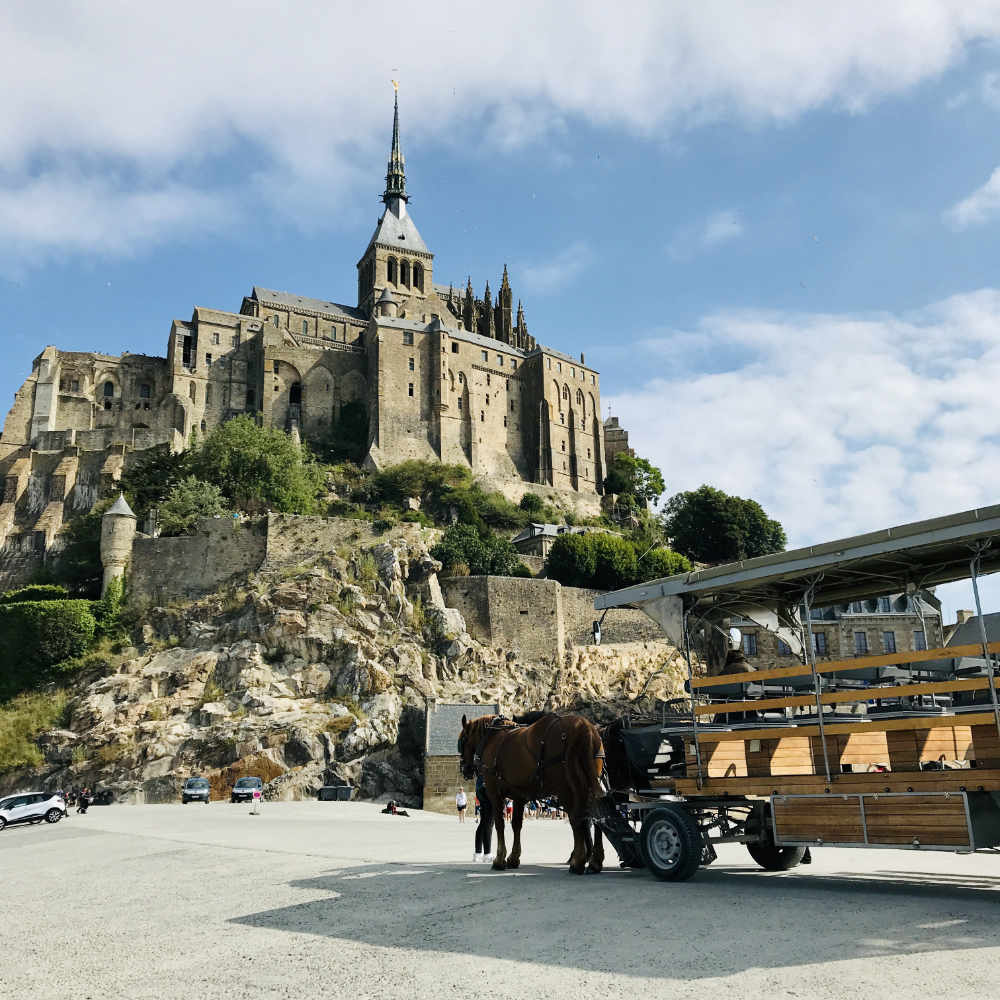
Surrounded by marshland, the waters turns the UNESCO World heritage site into an island when the tide comes in.
It takes about 4 hours to get there from Paris, and to get there from Paris you can take the train from Paris’ Gare Montparnasse to the city Rennes (2 hours), from where SNCF buses travel to Mont St. Michel (1.5hrs).
It is a bit of an adventure though, so this one day trip that I would strongly recommend going with a tour company. You can read more about visiting Mont Saint Michel here.
9. Château de Fontainebleau
In the words of Napoleon Bonaparte, Château de Fontainebleau was “the true home of kings, the house of ages.” While the glamorous Château de Versailles was a bit of a party palace, Château de Fontainebleau was the original working royal palace of the monarch, constructed centuries earlier.
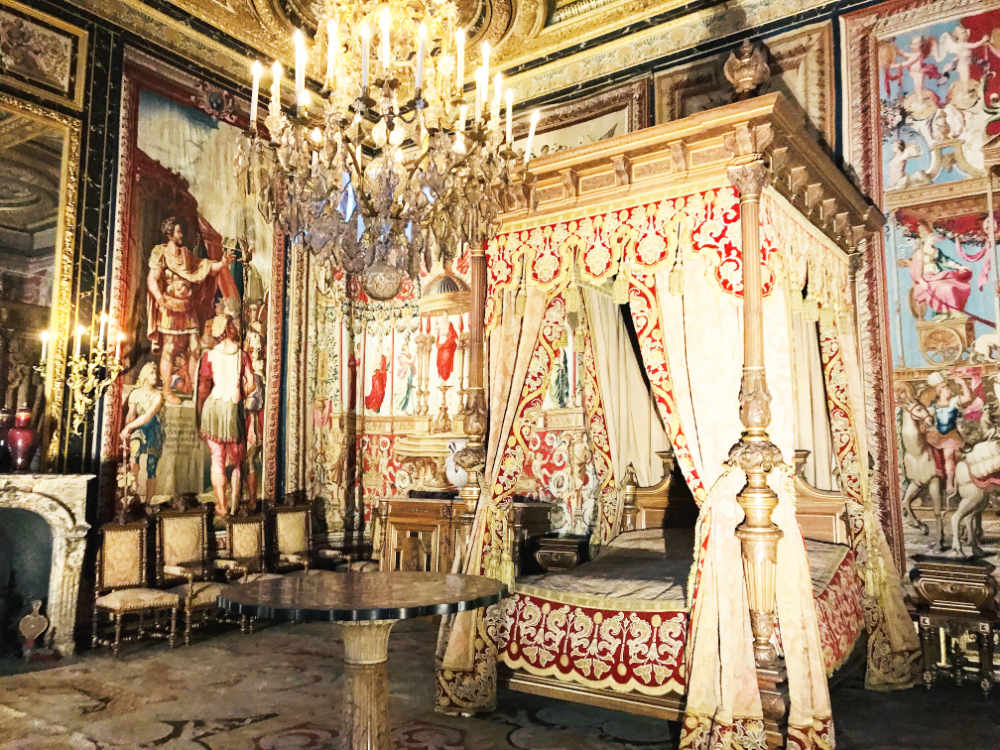
Further away from Paris than Versailles, Fontainebleau was originally constructed as a hunting lodge. Today it houses two exhibitions, both on larger-than-life French Kings: François I and Napoleon Bonaparte.
Of all the magnificent châteaux near Paris, this is perhaps the one with the most history. It is officially recognized as a UNESCO world heritage sites. You can read more about Château de Fontainebleau here, and find recommended tours from Paris.
10. Loire Valley Châteaux
It is lucky that the Loire Valley is about 2.5 hours away from Paris (by car), because that meant many of its luxurious renaissance châteaux were saved from the destruction of the French Revolution.
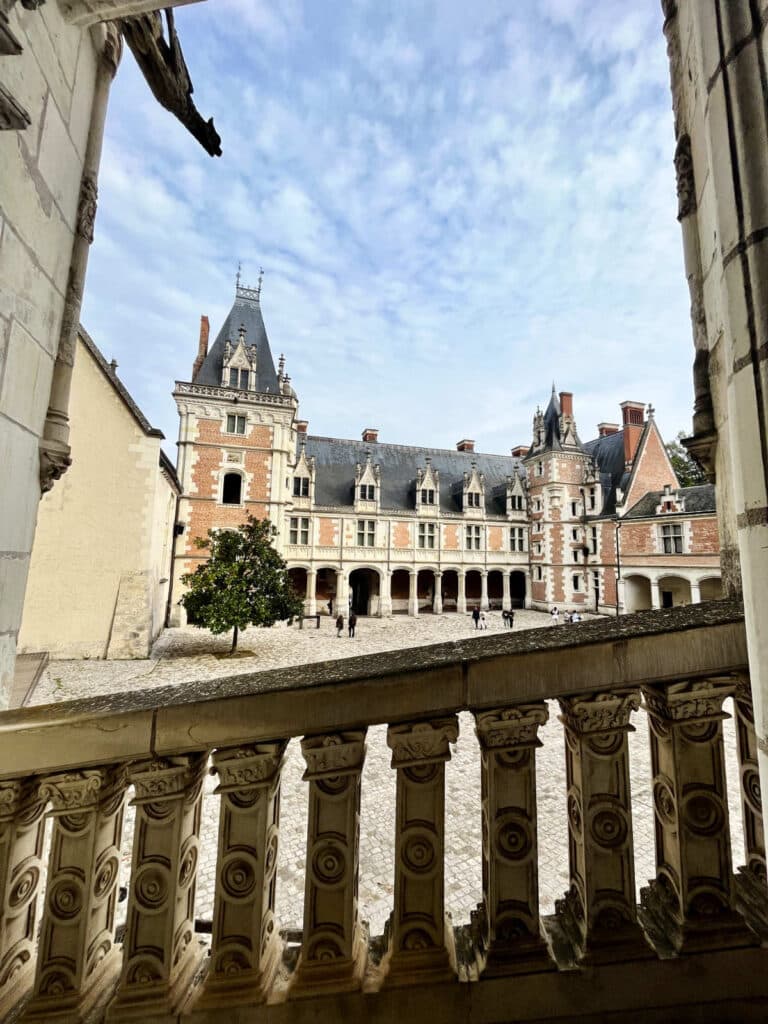
Chateau de Chenonceau and Chambord are two of its most famous. The beautiful city of Amboise has its own Royal Château that you shouldn’t miss.
In addition, the Loire Valley is a wine-producing region, so there are many popular white wines that are grown in the region, which you can read about here. The area is the second-largest concentration of sparkling-wine producing vines in France after the Champagne region.
And since they don’t build train stations next to castles, I would highly recommend taking a tour from Paris. There are several tours that combine wine-tasting and château-hopping as a day trip, or longer if you choose. You can see Loire Valley tour options here.
11. Provins
About an hour away from Paris by train, Provins is an ancient fortress town that is so well preserved, it has been inscribed on UNESCO’s world heritage list.
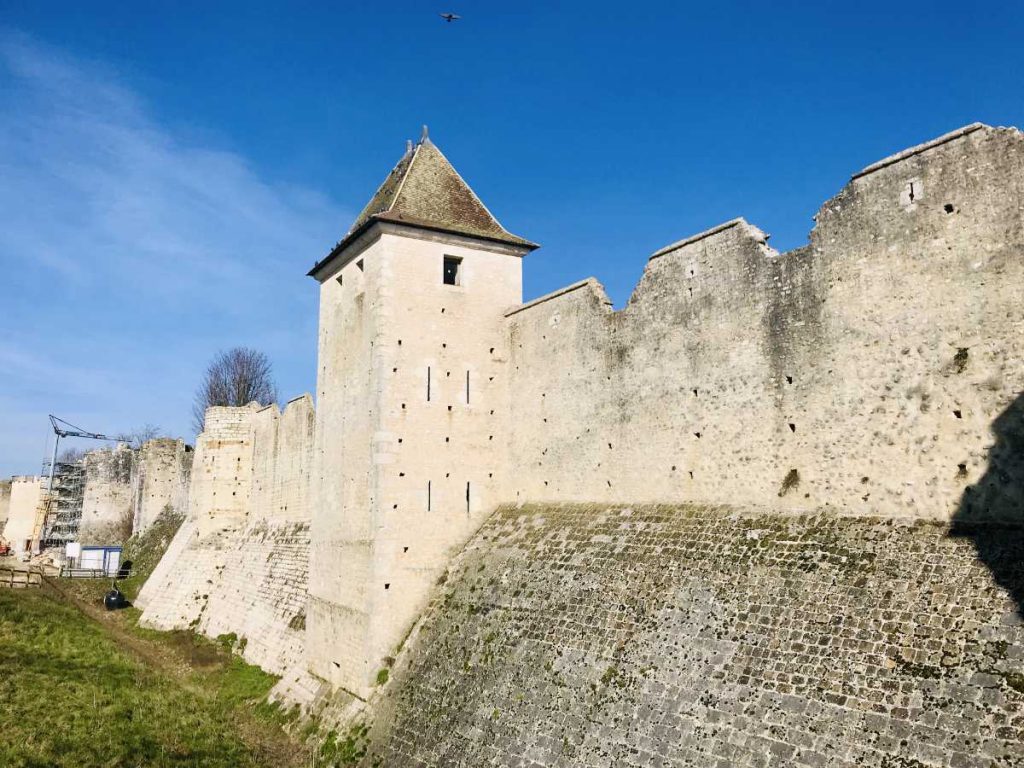
But Provins was never a royal city. Instead it was a city where nobility and royalty sent their servants to do their shopping. The town held the letters patent to hold annual events called the foires de Champagne (Champagne fairs), where tradespeople and merchants from far and wide would come to sell their wares.
This medieval town is best known these days for its famous “rose de provins”, which is used to make all kinds of rose confectionary.
There are also plenty of towers, ramparts, and dungeons to visit, along with a pedestrianized town center. You can read more about visiting Provins here.
12. Strasbourg Grand Ile
Located in the city of Strasbourg in Alsace, the Grand Ile is the large island that is in the heart of the city.
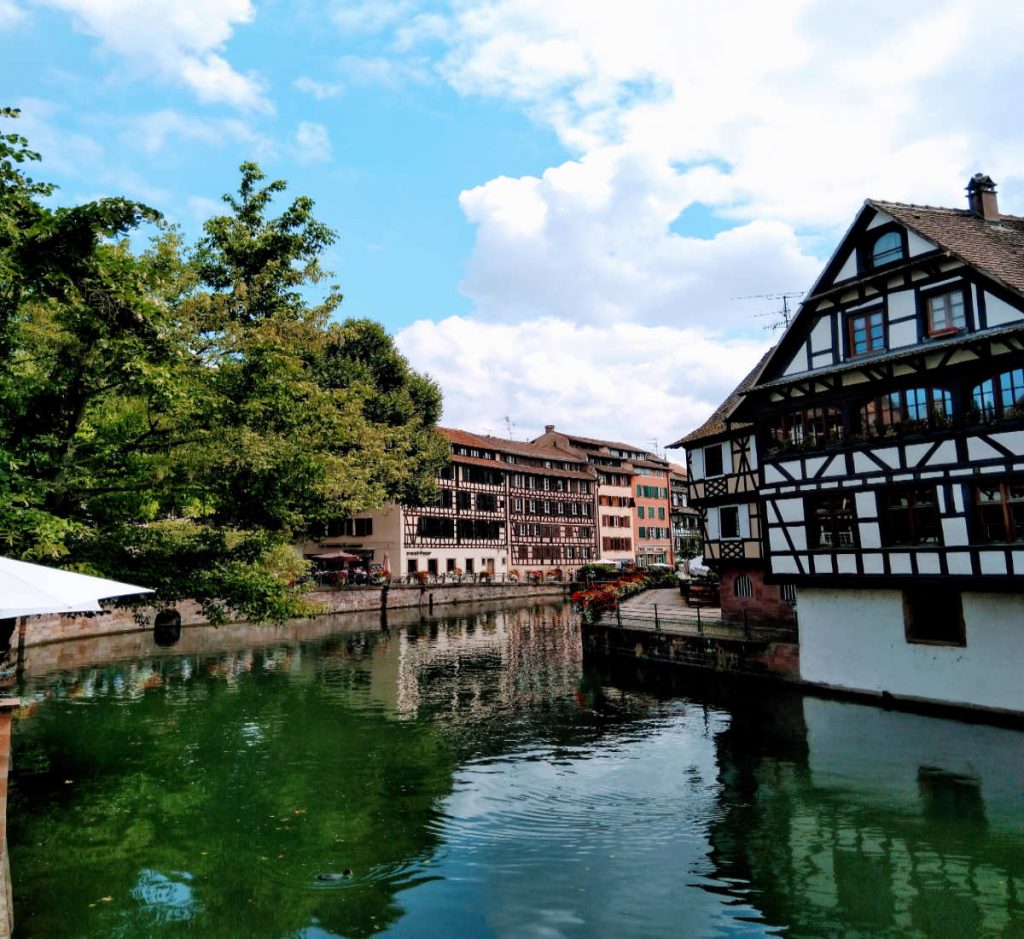
And who can have an island without a few bridges? This area is dotted with many small bridges, some dating from the medieval age.
Les Ponts Couverts are a set of three bridges and four towers that were erected in the 13th century. It is officially recognized as a UNESCO world heritage site. You can walk across the Pont, which is usually open between 9-7pm. Access is free.
13. Route of Santiago de Compostela
The Routes of Santiago de Compostela is one of the oldest religious pilgrimages in the world. It includes 71 monuments as well as 7 different paths, starting in Paris, Vezélay, Le Puy, and Arles and stretches across France into the north of Spain.
The sites include monuments, churches, or hospitals that provided services to pilgrims headed to Santiago de Compostela in Spain. Some of the notable sites on the Routes of Santiago de Compostela are:
- Amiens Cathedral
- Mont-Saint-Michel
- Basilica of St. Severinus in Bordeaux
- Romanesque church of Sainte-Foy at Conques
- Cathedral Saint Caprais in Agen
- Cathedral Sainte-Marie in Bayonne
- Church of Saint-Pierre at Moissac
- Basilica Saint-Vincent of Castres
- Basilica church of Saint-Sernin in Toulouse
- Collegiate church of Neuvy-Saint-Sépulchre
- Cathedral Saint-Étienne in Cahors
- Village of Rocamadour
14. Episcopal City of Albi
The Episcopal city of Albi is located in the Occitanie region of France, near Toulouse. It is a small town that is dominated by one of the most incredible churches in France that has been recognized by UNESCO
The Cathedral Basilica of Saint Cecilia, aka Albi Cathedral is thought to be the biggest medieval era brick building in the world. It was begun in 1282 and was under construction for 200 years.
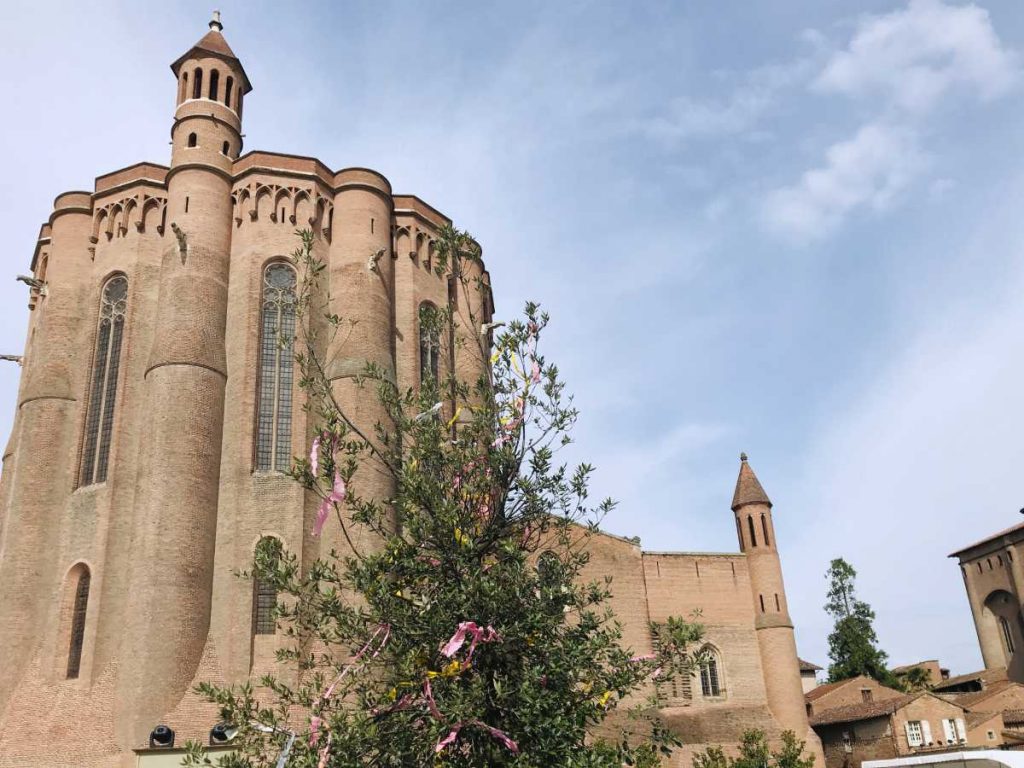
A UNESCO world heritage site, the earliest church that stood here dated back to the 4th century. It is named for Saint Cecilia, a wealthy Roman noblewoman and martyr, who was a patroness of musicians.
The current cathedral is a medieval gothic cathedral and was built to impose Catholic rule in the area.
In the 12th century, Albi was part of the Province of Languedoc, ruled by the Count of Toulouse, who owed allegiance to the King of France. The region became a battleground between the established church and the followers of a dissident religious movement called Catharism.
The Cathars had a strong presence in Albi at the time, leading the Catholic pope to launch the Albigensian Crusade in 1208 to destroy the Cathars in southern France.
It ended in 1209 with the defeat and massacre of the Cathars at Carcassonne, and the end of the semi-independence of the states of Languedoc.

The Cathedral was built a few years later to install a Catholic bishop in the area, and ensure that Catharism did not reestablish itself in the area.
Inside, you can see its beautifully preserved blue and gold ceilings as well a large rood screen (jubé in French) that is on one side of cathedral. It is an ornamental and intricate fence that was reserved for the clergy to pray without being disturbed. You can read more about visiting the Episcopal city of Albi here.
15. Notre-Dame Cathedral of Chartres
One of the most impressive sights to see in city of Chartres is the Cathedral of Our Lady of Chartres. Built between 1194 and 1220, there were 5 earlier churches on this spot dating back to the 4th century. It is officially recognized as a UNESCO world heritage site.
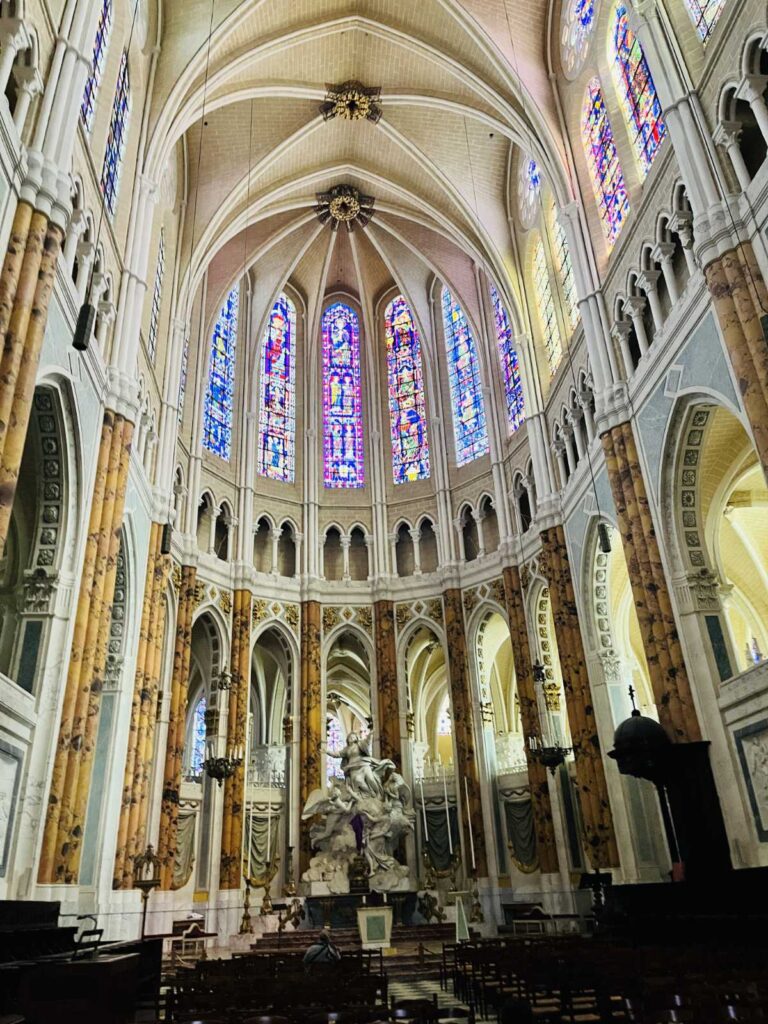
It is a beautifully preserved gothic church with a lot of its stained glass windows remaining intact through France’s many wars and revolutions. Since the 11th century, it has been the seat of the Bishop of Chartres.
It is here that Good King Henri IV was crowned King of France on 27 February 1594. Henri was a Protestant and had recently converted to Catholicism to try to convince the local French catholics to accept him.
Reims cathedral, the traditional seat where royals were crowned, and the iconic Notre Dame de Paris were still in Catholic hands. Hence the historic town of Chartres which was nearby was chosen for the coronation. You can read more about visiting Chartres here.
16. Champagne hillsides, houses and cellars
The most famous of French wines (yes, it counts as a wine, of the sparkling variety), has of course to be Champagne. When you think of luxury and prestige, it is usually accompanied by a glass of Champagne.
In recognition of this, UNESCO has selected the hillsides where champagne is grown along with its houses and cellars as protected world heritage sites.
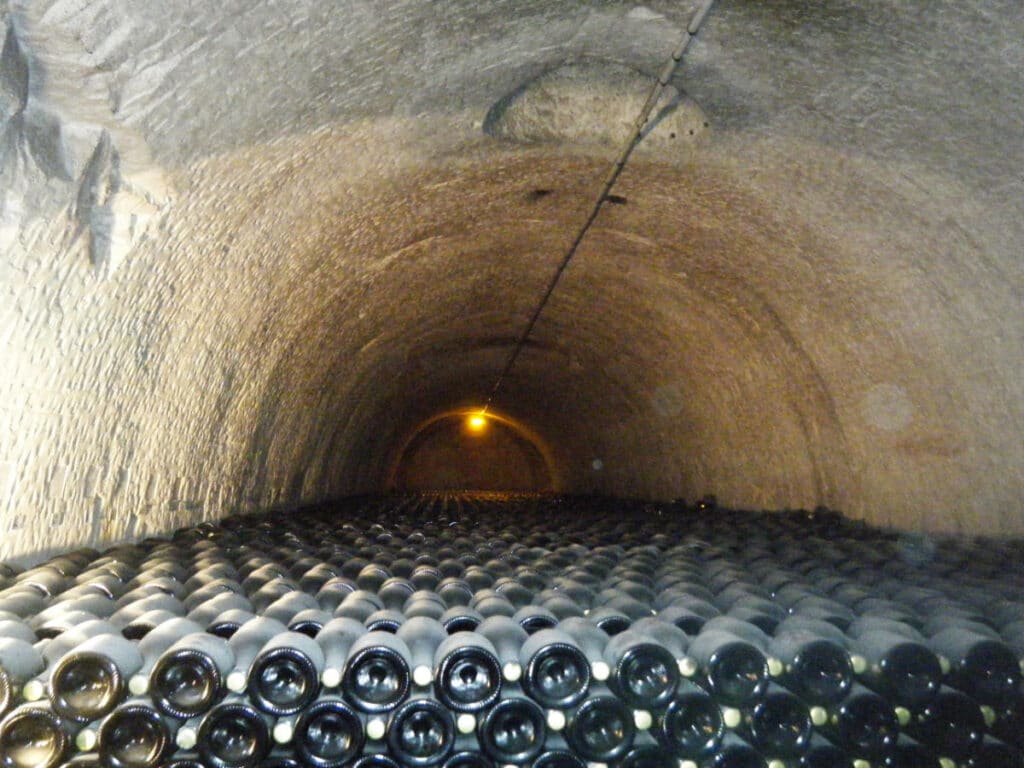
Sparkling wines have been produced in France as early as the days of the Roman Empire. But the name “Champagne” became famous in France after a monk named Dom Perignon in the 17th-century in the outskirts of Reims, came up with the idea of matching grapes together to come up with particular notes (rather than throwing random grapes together).
He also used thicker bottles which helped prevent the bottles from exploding during transport. Today the name “Champagne” is officially protected in France and through international treaties with an “AOC – appellation d’origine contrôlée“.
17. Paris, banks of the Seine
Paris is one of the most scenic cities in the world. With the river Seine running through the city and a couple of small islands dotting the center, the banks and bridges of Paris connect the city’s different neighborhoods and quartiers.
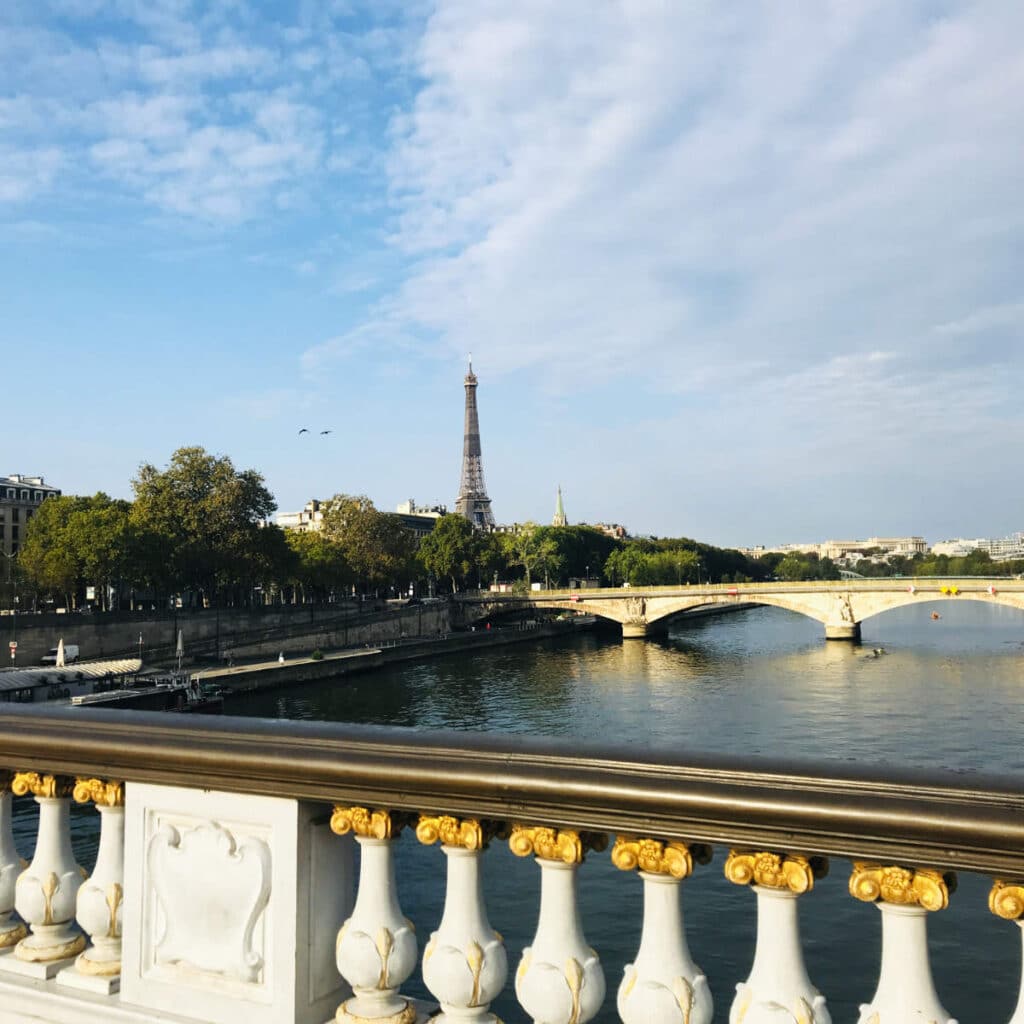
Some of its most iconic sights along the banks of the river Seine date back in the city’s history. These include the Notre Dame Cathedral, Conciergerie, Louvre Museum, Concorde, Assemblée Nationale and up to the more recent Eiffel Tower.
Such is the renown of these places that Paris and the banks of the Seine have been designated as UNESCO world heritage sites.
18. Historical center of Avignon
One of the most interesting UNESCO heritage sites is the French walled city of Avignon in Provence. Much of its fame stems from the 13th century. when the King of France insisted that the Roman Catholic church and its Pope move to Avignon.
It was a controversial move. A landmark palace was built as a fortress for the Pope on a small hill, with high walls surrounding it and the city. This walled city has been preserved, with large parkings built underground, and its center mostly pedestrianized to keep its charm.
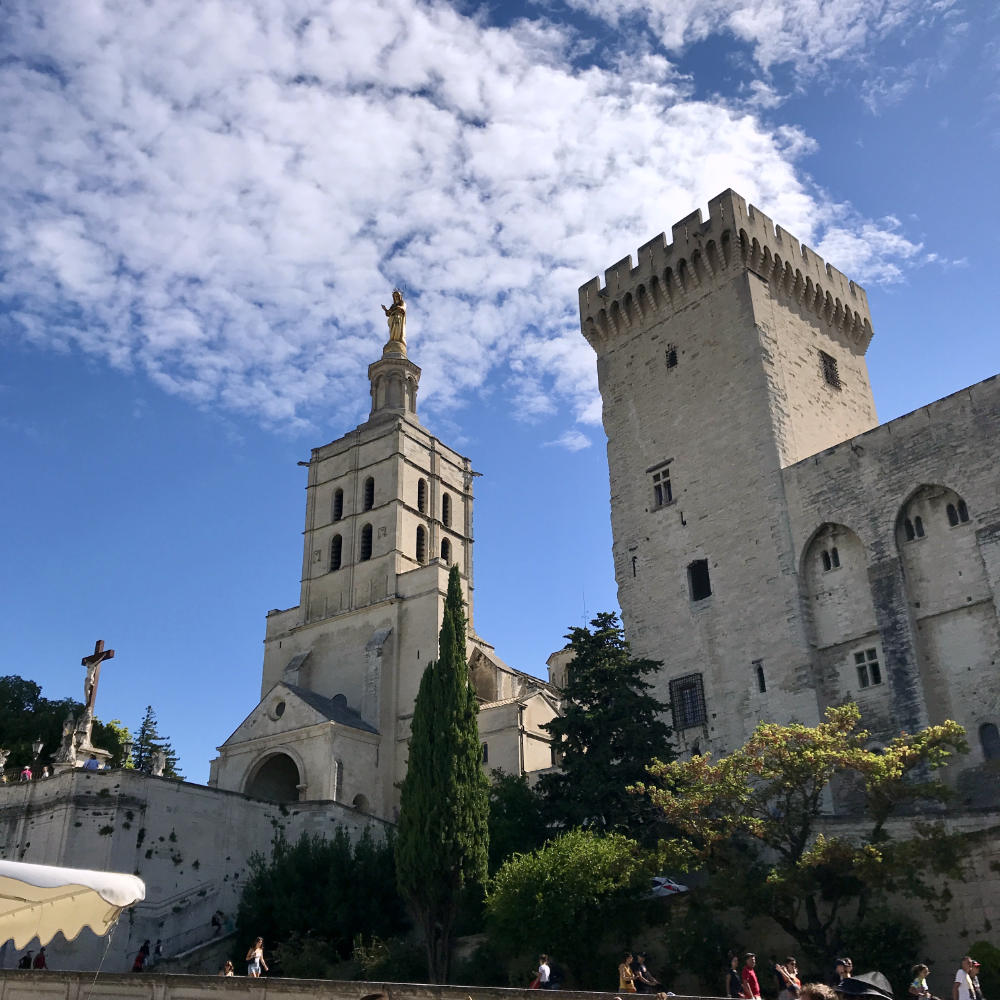
At the center of Avignon stand the former Papal Palace. Constructed in the 13th century, the Palace is still one of the largest gothic medieval buildings in Europe.
The palace gradually deteriorated after the popes left in 1377, and was even used as military barracks and a prison by Napoleon Bonaparte as he went around conquering Europe.
Other famous sites within the city is the Pont d’Avignon bridge, also known as the Saint Bénézet Bridge. In addition is the Cathedral of Notre-Dame des Doms which lies just north of the Papal Palace, dating back to 1150. You can read more about visiting Avignon here.
19. Fortifications of Vauban
The Alpine town of Briançon on the French border was heavily fortified under Sun King Louis XIV in the 17th century to keep out Austrian invaders.
This area called Forteresse Vauban after his engineer, Vauban, who constructed several fortifications all along the French border with Germany, Italy and Switzerland.
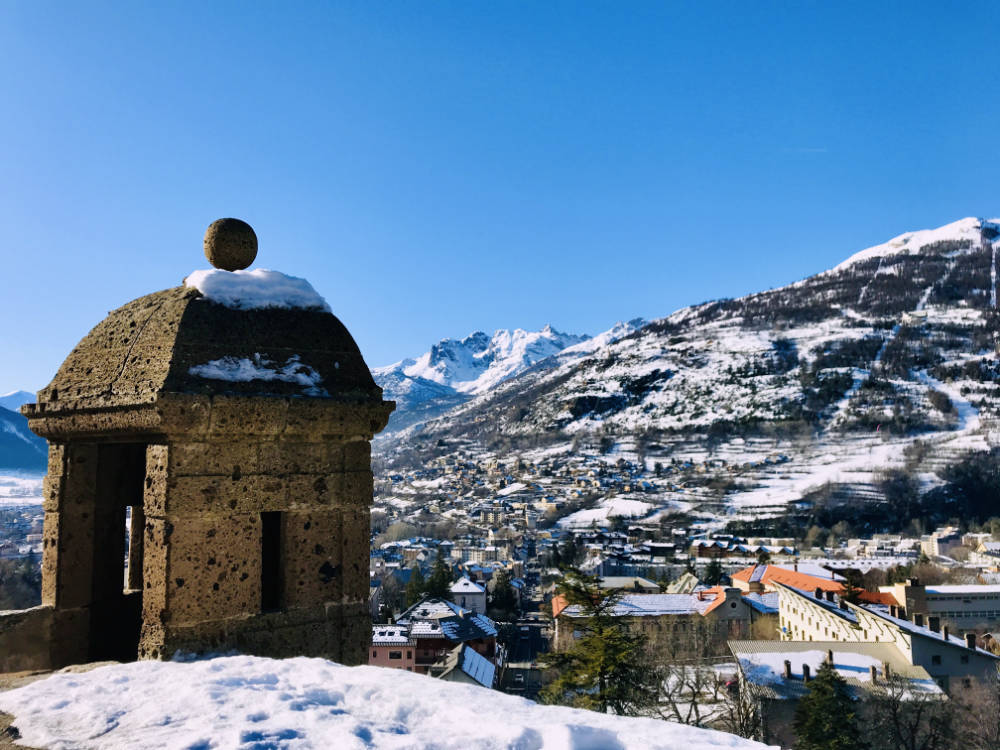
Sébastien Le Prestre de Vauban (1633-1707) constructed several fortifications in the Alps and surrounding area.
The Fortification of Vauban consists of 12 groups of fortified wall and castles along the western, northern and eastern borders of France. They have been officially designated a UNESCO world heritage site.

20. Nice, winter resort town
The quintessential beach city in France has to be the city of Nice on the French Riviera (Côte d’Azur). If you are looking for sun-filled days with sea views the city of Nice is the place to be.
Nice has been designated a UNESCO world heritage site because of its status on the Riviera attracting wealthy Europeans looking to escape a cold winter. From the mid-18th century, the site attracted growing numbers of aristocratic and upper-class families.
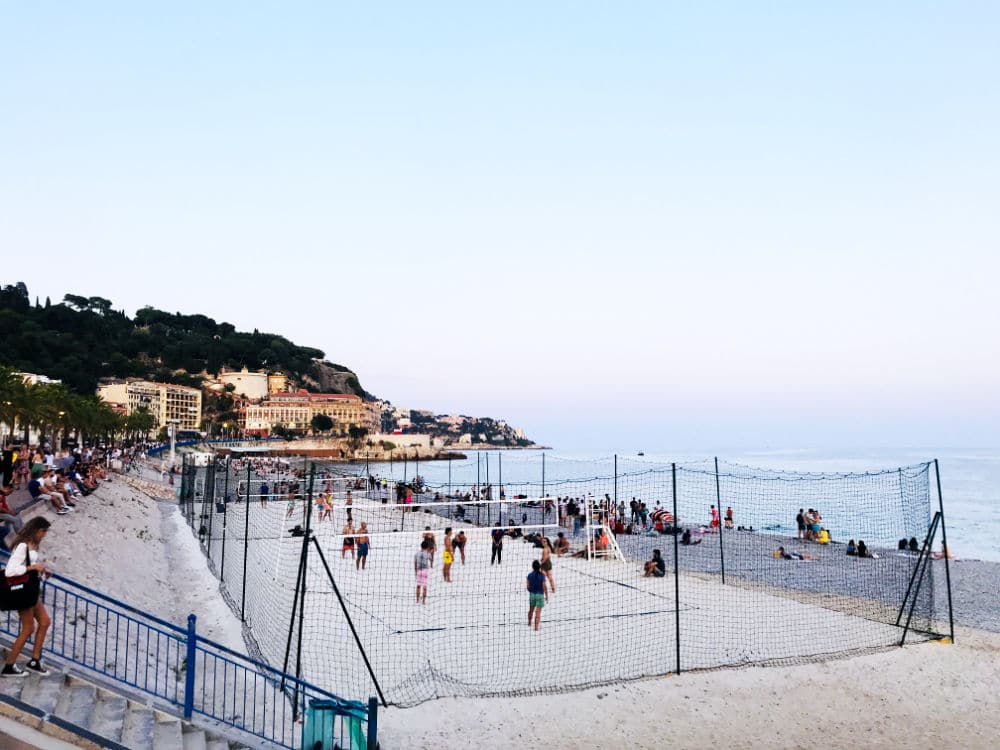
Once part of the Duchy of Savoy, it only became part of France in the 19th century. And since then, with its famous Promenade des Anglais boardwalk and long expansive beaches, this is a seaside town that both tourists and locals regularly flock to.
But there is more to Nice than just beaches and boardwalks. Dating back to antiquity, the city has always attracted an amalgam of visitors from across the Mediterranean sea.
With a niçois culture that is a mix of French, Savoyard and Italian, it is a city bustling with good food, restaurants, bars, shops and museums.
Other towns nearby include Monaco and Cannes, which are just a short train ride away. You can read more about the city of Nice here.
21. Spa towns of France
France is renowned for its picturesque spa towns which have been designated as UNESCO world heritage sites. From ancient Romans to Queen Victoria of the UK, these towns have long been sought-after destinations for relaxation, rejuvenation, and healing.
One such notable spa town is Aix-les-Bains, situated on the eastern shores of Lake Bourget. Its thermal springs, dating back to Roman times, are famous for their healing properties, attracting visitors seeking relief from various ailments.

Other gems among France’s spa towns are Vichy, Aix-en-Provence, and Greoux-les-Bains. In addition, Evian-les-Bains is famous for its pure and mineral-rich water, which gave birth to the renowned Evian brand.
Although not as famous as they once were, locals and tourists still flock to these spa towns for a bit of rest and relaxation.
22. Place Stanislas, Place de la Carrière and Place d’Alliance in Nancy
The small city of Nancyin northeastern France, is home to three remarkable UNESCO World Heritage Sites: Place Stanislas, Place de la Carrière, and Place d’Alliance.
These architectural masterpieces were designed in the 18th century by King Stanisław I of Poland who had to flee his homeland to France, and would go on to become the Duke of Lorraine. (His daughter Marie was married to the King Louis XV of France. Stanislas was also instrumental in the recipes for French onion soup and baba au rhum cake!)
At the heart of Nancy is the iconic Place Stanislas, named after him. A bronze statue of Stanisław I stands as a testament to him. Nearby are the equally impressive Place de la Carrière and Place d’Alliance which were all designed and constructed between 1752 and 1756 by the architect Emmanuel Héré.
23. Historic center of Lyon
History tells us that it was Lyon that was the capital of Roman Gaul (as France was then known), the most important city in this part of Europe. In the time before Christ, 43 BC, the city was known as Lugdunum.
The Roman Empire considered it so important that 2 future Roman emperors were born here, Claudius and Caracalla. As such, there are several Roman ruins in the city.
Since the city used to be a Roman colony, many traces of that Empire remain, including the Ancient Theatre of Fourvière. Roman architecture and influence stands out all across the city and most prominently in these two ancient Roman theatres located in the Fourvière area.

The larger of these is the oldest Roman theatre in France, dating back 2000 years. This ancient theatre of Fourvière had space for 10,000 people – you can imagine the grandeur of the events that were held here! The Romans were known for indulgence and this is a prime example of it.
This ancient theatre was restored in the last century and is now a UNESCO World Heritage site. It is used as a venue for popular events such as operas, dances, and musical festivals. With an expansive view out to the city, it is a beautiful location to visit.
Another noteworthy site is Aqueduct of the Gier. It is an ancient Roman aqueduct that was constructed in the 1st century AD to provide water for Lugdunum (Lyon). It is the longest and best preserved of four Roman aqueducts that used to serve the city. You can read more about visiting Lyon here.
24. Le Havre, the city rebuilt
Le Havre is a small port city situated on the mouth of the river Seine in Normandy. It was founded by King François I in 1517 because the nearby port at the city of Honfleur was starting to be too small.
From the entrance at Le Havre, boats could travel all the way down the Seine to Paris, bringing trade and commerce.

Le Havre was severely bombed during WWII because of its location and had to be entirely rebuilt after the war. The team was led by Auguste Perret who managed the project.
And nothing epitomizes the new Le Havre more than the Pont de Normandie bridge which was completed in 1995. At the time, it was the longest cable-stayed bridge in the world, and also had a record distance between piers for a cable-stayed bridge.
It is the the last bridge to cross the Seine before it empties into the Atlantic ocean. You can read more facts about Normandy here.
25. Amiens Cathedral
The Basilique Cathédrale Notre-Dame d’Amiens is a Roman Catholic church in the the city of Amiens in the Picardy region of northern France. The cathedral is the seat of the Bishop of Amiens.
Unlike other cathedrals in France which were built over a long period of time, the Amiens Cathedral was almost entirely built between 1220 and 1270. This remarkably short period of time gives it a unified look since plans for the cathedral were not constantly changing.
The Amiens cathedral is also the largest cathedral in France, large enough to contain two cathedrals the size of Notre Dame of Paris. It is officially recognized as a UNESCO world heritage site.
The cathedral hosted the wedding in 1193 of King Philip II, the first king to style himself as “King of France” rather than “King of the Franks”.
He married his 2nd wife Ingeborg of Denmark at Amiens Cathedral, the same day she arrived at the city. In a rather soap operatic episode, Philip changed his mind during the ceremony and tried to send the 19-year old Ingeborg away to Soissons, claiming that the marriage hadn’t been consummated.
He later took a 3rd wife, before the Pope intervened and insisted that Ingeborg was indeed his wife and Queen. Ingeborg spent much of her life locked away by Philip, only finally being acknowledged in 1213, 20 years after their marriage at Amiens Cathedral.
26. Saint-Emilion (Bordeaux)
Wines from Bordeaux are some of the most famous and expensive in the world. And the Saint Emilion region is a UNESCO protected site along with being a Bordeaux AOC of great distinction.
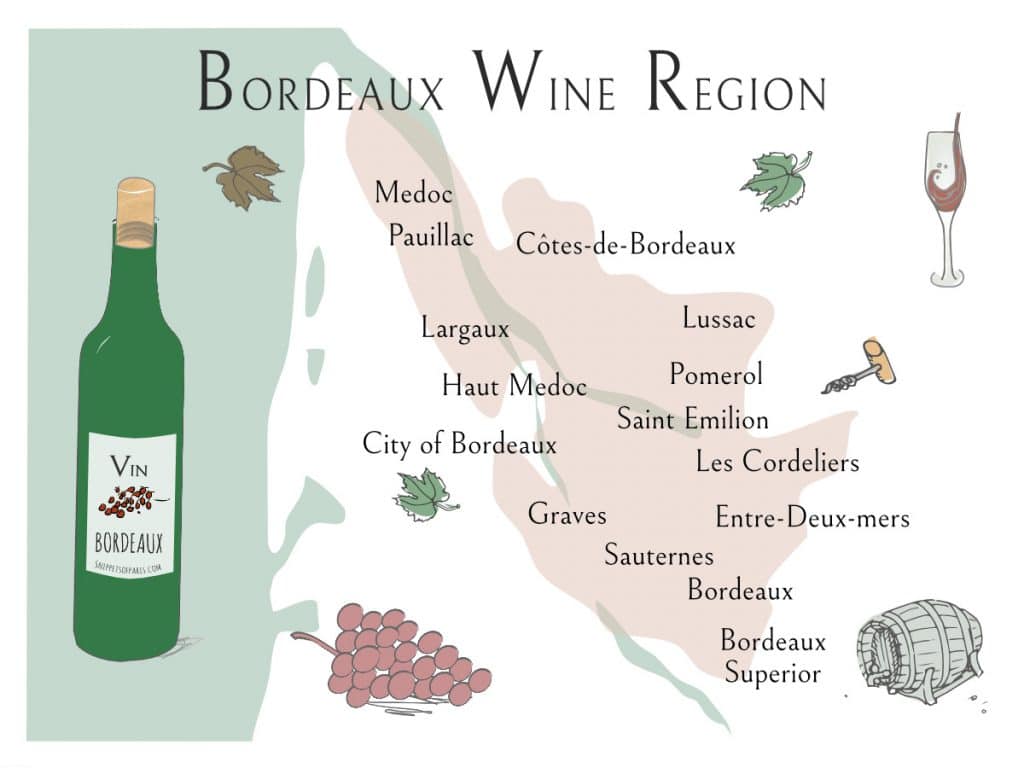
The area has been famous for its viticulture since Roman times. In addition, the region was popular because of its location along one of the pilgrimage routes to Santiago de Compostela.
The wines of Saint-Émilion are typically blended from different grape varieties, the Merlot (60% of the blend), Cabernet Franc (nearly 30%) and Cabernet Sauvignon (around 10%). This fruity red wine has discreet notes of vanilla and spices. You can read more about Saint-Emilion here.
27. Rocamadour
The tiny village of Rocamadour in Occitanie is a UNESCO heritage site that has attracted visitors for centuries, among them pilgrims, kings, and nobility.
It is known for its position, perched 150m high on a hillside overlooking the Alzou canyon. It has been a place of worship since the Middle ages for those to come to pray at the chapel to the Black Virgin after having climbed the 216 steps pilgrims’ staircase.
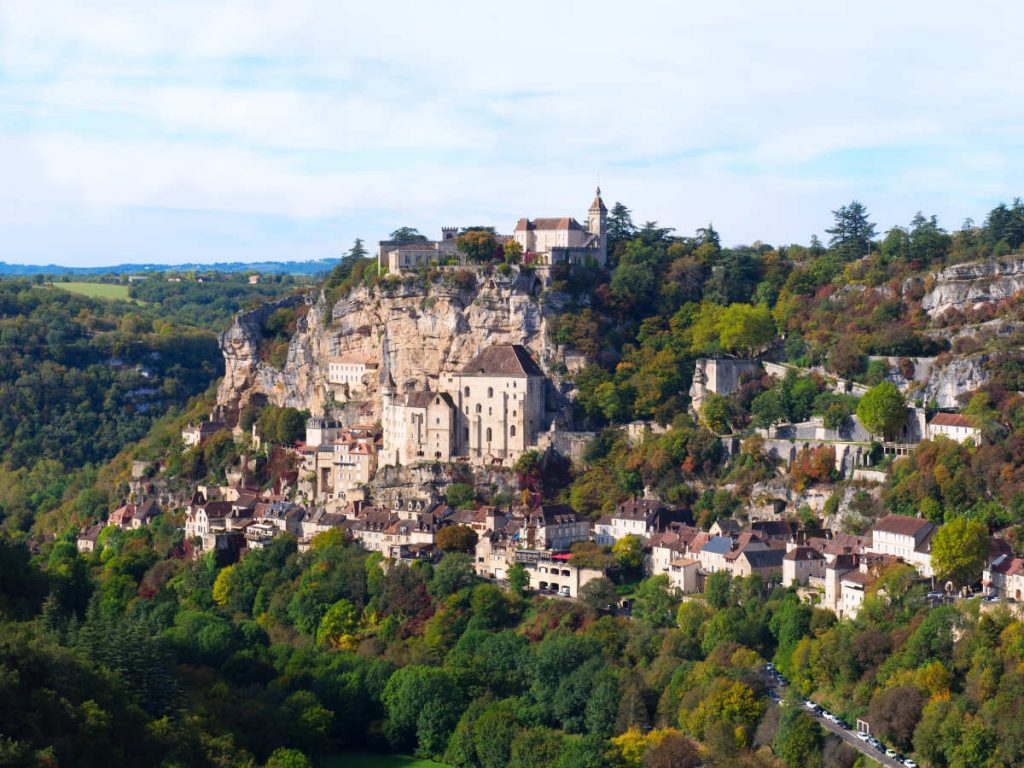
Rocamadour is also one of the stops on the pilgrimage route of Saint-Jacques de Compostelle. You can take a tour to Rocamadour from Bordeaux or Sarlat-la-Canéda.

If you enjoyed this article, you may like to read about the top landmarks in France. A bientôt!

